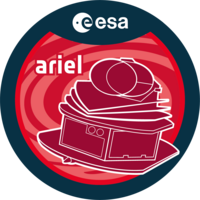| Names | Atmospheric Remote-sensing Infrared Exoplanet Large-survey |
|---|---|
| Mission type | Space telescope |
| Operator | ESA |
| Website | arielmission |
| Mission duration | 4 years (planned) [1] |
| Spacecraft properties | |
| Launch mass | 1,300 kg (2,900 lb) [2] |
| Dry mass | 1,000 kg (2,200 lb) |
| Payload mass | 300 kg (660 lb) |
| Start of mission | |
| Launch date | 2029 (planned) [3] |
| Rocket | Ariane 62 |
| Launch site | Centre Spatial Guyanais, Kourou, ELA-4 |
| Contractor | Arianespace |
| Orbital parameters | |
| Reference system | Sun–Earth L2 orbit[4] |
| Main Cassegrain reflector | |
| Diameter | 1.1 m × 0.7 m (3 ft 7 in × 2 ft 4 in) |
| Focal length | f/13.4 |
| Collecting area | 0.64 m2 |
| Wavelengths | visible and near-infrared |
| Instruments | |
| Telescope assembly (TA) Ariel infrared spectrometer (AIRS) Fine Guidance System (FGS) | |
 ARIEL mission insignia | |
The Atmospheric Remote-sensing Infrared Exoplanet Large-survey (ARIEL) is a space telescope and the fourth medium-class mission of the European Space Agency's Cosmic Vision programme. The mission is aimed at observing at least 1000 known exoplanets using the transit method, studying and characterising the planets' chemical composition and thermal structures. Compared to the James Webb Space Telescope, ARIEL will be a much smaller telescope and have more observing time available for planet characterisation. ARIEL is expected to be launched in 2029 aboard an Arianespace Ariane 6 together with the Comet Interceptor.
- ^ "ARIEL Summary". ESA. 11 November 2020. Retrieved 12 June 2021.
- ^ "ARIEL Spacecraft". ESA. 11 November 2020. Retrieved 12 June 2021.
- ^ Cite error: The named reference
esa-20201112was invoked but never defined (see the help page). - ^ "Ariel Space Mission – European Space Agency M4 Mission". Retrieved 7 December 2021.